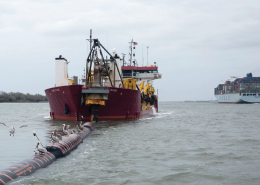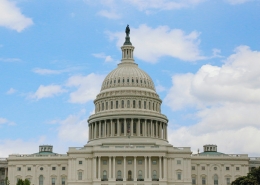On Thursday, November 9, the Aviation Subcommittee of the Senate Committee on Commerce, Science, and Transportation met to discuss aviation safety in light of multiple high-profile near misses at U.S. airports. Chaired by Senator Tammy Duckworth (D-IL), the subcommittee explored the causes of near misses and potential safety improvements.
Five witnesses testified at the hearing (click on their name to read their prepared testimony):
- Jennifer Homendy – Chair, National Transportation Safety Board (NTSB)
- Tim Arel – Chief Operating Officer, Federal Aviation Administration (FAA) Air Traffic Organization
- Rich Santa, President – National Air Traffic Controller Association (NATCA)
- Capt. Jason Ambrosi – President, Air Line Pilots Association (ALPA)
- Randy Babbitt – Principal Partner, Babbitt & Associates, LLC (and former FAA Administrator)
On January 13, a Delta Air Lines flight at John F Kennedy Airport in New York City was forced to abort its takeoff after an American Airlines jet crossed the runway ahead of it. A similar incident occurred in March in New Orleans. On February 4, a FedEx Freighter was instructed to land on a runway while a Southwest Airlines plane was taking off. Unfortunately, these are just a few examples of many. According to a New York Times analysis, over the most recent twelve month period for which data is available, there have been over 300 near misses involving commercial aircraft in the United States.
There has not been a fatal commercial incident involving a U.S. airliner since Colgan Air Flight 3407 crashed outside of Buffalo, NY in February 2009, killing all 49 people on board. As a result of this crash, Congress included multiple increased safety measures in the Airline Safety and Federal Aviation Administration Extension Act of 2010, including changes to pilot rest requirements and a requirement known as the 1500-hour rule, which mandates that both pilots of commercial aircraft be in possession of an Airline Transport Pilot (ATP) license, with 1500 hours of flight time (with some exceptions). Thursday’s hearing doubled down on this rule as a contributing factor to the safest airspace in the world, explored causes of the uptick of near misses such as increased demand and shortages of air traffic controllers, and recommended potential safety improvements.
The World’s Safest Airspace
Some have proposed changing the 1500-hour rule to address pilot shortages, but many in the industry are not supportive of these changes, starting with chairman Duckworth herself, who said that tinkering with the rule would jeopardize safety. Duckworth, a former military pilot herself, is intimately familiar with airspace safety regulations and requirements. While the United States may have the safest airspace, western European countries, Canada, China, Australia, Japan, and New Zealand are not far behind. These counties do not require 1500 flight hours to become a commercial pilot, but only 250 hours and specialized airline training and mentorship. Although the 1500-hour rule has likely helped maintain airspace safety in the United States, it seems unlikely that it is the only or most prevalent factor. The NTSB and the FAA have both agreed that flight hours themselves are not an accurate reflection of pilot knowledge, skills, or professionalism.
Senator Duckworth and the panel of witnesses discussed how and if changes to the 1500-hour rule should be made. The panelists generally agreed that immersive simulator training is a helpful tool that can supplement some in-air experience, but it cannot completely replace flight time. Randy Babbitt, who served as the Administrator of the FAA from 2009 to 2011, asserted that simulators enhance safety greatly; simulators allow pilots to experience crisis situations that you wouldn’t intentionally put pilots through in the air (i.e. in heavy icing conditions). Babbitt also pointed out that when you are first starting training, you don’t need a multimillion-dollar simulator to learn where the switches are, but these less immersive simulators should not count as flight time.
Capt. Jason Ambrosi (ALPA) agreed that simulators are critical training tools but that you need real world experience as well as better training. Babbitt added that the 1500-rule was not meant to be static; the 2010 legislation clearly states that supplemental training may offset flight hours requirements when it improves safety. Backed by substantial data, two FAA rulemaking committees both unanimously supported supplemental training and recommended curriculum to replace simple flight hours with advance training and mentors. This guidance has not been implemented, but Babbitt thinks it should be and indicated that the current FAA administrator agrees.
An Increase in Near Misses
The increase in safety incidents has been particularly prevalent over the last 3 years: in FY23 there were 23 serious runway incursions, up from 16 in FY22 and 12 in FY21, according to the NTSB. The witnesses identified two likely causes: staffing constraints for air traffic controllers (ATCs) and quick increase in air traffic demand post-pandemic that has put increased strain on both flight and ground crews. According to Rich Santa (NATCA), there are 1,000 fewer ATCs than there were a decade ago. Santa asserted that ATC hiring is based on a flawed staffing model that was developed over a decade ago. He reminded the committee that ATC staffing would be made worse through the course of a government shutdown as the FAA would be forced to stop all hiring and training.
A rapid resurgence of flight demand has required pilots and ATCs to work longer hours and more irregular shifts, which as Jennifer Homendy (NTSB) pointed out, likely increases fatigue which leads to increased incidences of error. Pilots currently have rest requirements, but no similar requirement exists for controllers. Santa indicated that while rest rules are needed, the current problem with ATC is with staffing, and it is not something that can be fixed with schedule optimization or rest requirements. Mental health challenges were also noted; Senator Ted Crux (R-TX) asked Homendy to elaborate on previous comments that indicated that current rules incentivize pilots to lie about their mental health history. Homendy doubled down saying that using CDC numbers, 1 in 5 U.S. adults are living with a mental health challenge. FAA civil airman statistics indicated that there are 757,000 pilots currently licensed in the United States, meaning that potentially over 100,000 pilots are facing challenges, many of whom do not report them or avoid getting help for fear of losing their ATP license and job.
Safety Improvements
The witnesses explored multiple policy actions to continue to improve safety in U.S. airspace. Santa indicated that the most important thing Congress can do is to pass a long-term, comprehensive FAA reauthorization bill before the end of this year, which he hopes would direct the FAA to adopt new controller workforce targets (that have already been developed by the Collaborative Resources Workgroup) and maximize controller hiring for the duration of that bill. (Ed. Note: The House has passed a multi-year bill, but the hangup is the Senate, where a dispute over how to amend the 1500-hour rule is the holdup.)
Santa also indicated that the FAA needs to be more transparent about its need for increased funding for its facilities and equipment budget. Congress has usually met the FAA’s annual request, but these annual requests have consistently been less than what is actually needed, not even adjusting for inflation, according to Santa. This has created a significant backlog of needed improvements. Homendy also underscored the importance of adequate funding, asking that the Senate, which is currently proposing $134.3 million annually for the NTSB, to match the proposed $145 million in the draft House bill; agency staffing and funding levels have remained mostly stagnant since 1997, but even with these constraints Homendy has led her agency to eliminate investigation backlog entirely, boost staffing, and make significant investments in IT.
Technology improvements also have the potential to improve safety by increasing redundancy that keeps errors from becoming catastrophic. Capt. Ambrosi indicated that ALPA strongly supports moving NextGen forward to allow pilots and ATCs to better pinpoint the position of aircraft both on the ground and in flight. The Senate version of the reauthorization bill currently includes $18.2 billion over five years to upgrade all large and midsized airports with Airport Surface Detection Equipment (ASDE). Tim Arel indicated that the FAA held a safety summit in March, among other initiatives, to enhance flight safety and reduce incursions.
Although air travel in the United States is the safest in the world, even one death is too many. It is critical that congress continue to work with industry stakeholders and government regulators to increase air safety through the FAA reauthorization bill.













